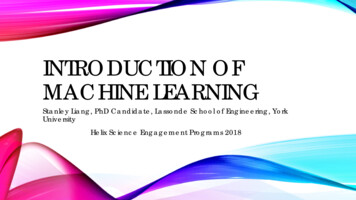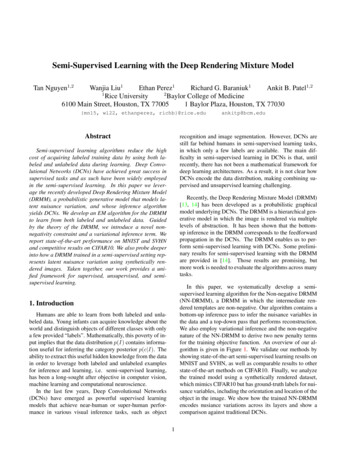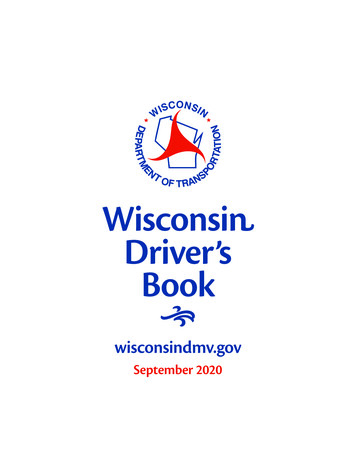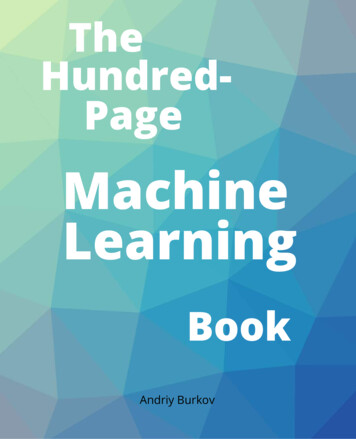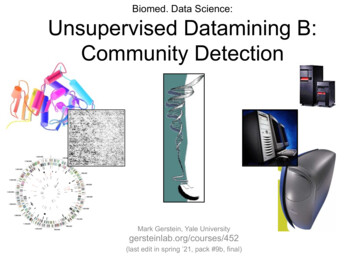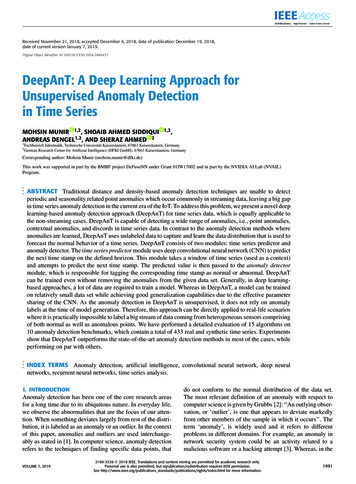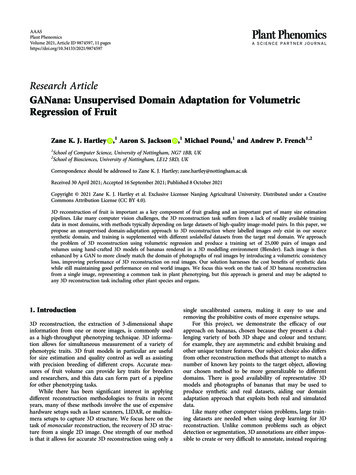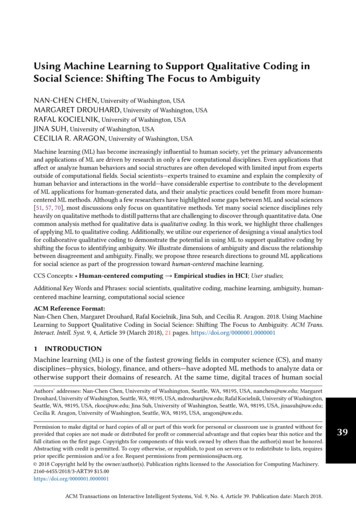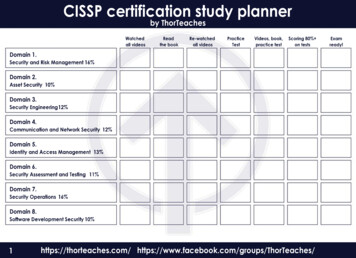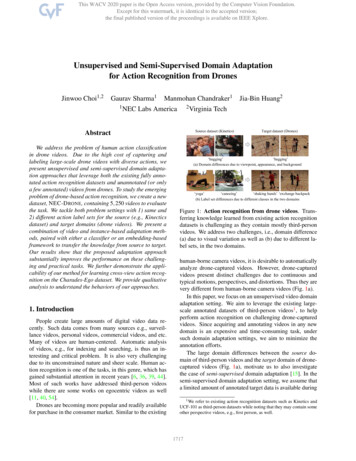
Transcription
Unsupervised and Semi-Supervised Domain Adaptationfor Action Recognition from DronesJinwoo Choi1,2Gaurav Sharma11 NECManmohan Chandraker12 VirginiaLabs AmericaWe address the problem of human action classificationin drone videos. Due to the high cost of capturing andlabeling large-scale drone videos with diverse actions, wepresent unsupervised and semi-supervised domain adaptation approaches that leverage both the existing fully annotated action recognition datasets and unannotated (or onlya few annotated) videos from drones. To study the emergingproblem of drone-based action recognition, we create a newdataset, NEC-D RONE, containing 5, 250 videos to evaluatethe task. We tackle both problem settings with 1) same and2) different action label sets for the source (e.g., Kinecticsdataset) and target domains (drone videos). We present acombination of video and instance-based adaptation methods, paired with either a classifier or an embedding-basedframework to transfer the knowledge from source to target.Our results show that the proposed adaptation approachsubstantially improves the performance on these challenging and practical tasks. We further demonstrate the applicability of our method for learning cross-view action recognition on the Charades-Ego dataset. We provide qualitativeanalysis to understand the behaviors of our approaches.1. IntroductionPeople create large amounts of digital video data recently. Such data comes from many sources e.g., surveillance videos, personal videos, commercial videos, and etc.Many of videos are human-centered. Automatic analysisof videos, e.g., for indexing and searching, is thus an interesting and critical problem. It is also very challengingdue to its unconstrained nature and sheer scale. Human action recognition is one of the tasks, in this genre, which hasgained substantial attention in recent years [6, 36, 39, 44].Most of such works have addressed third-person videoswhile there are some works on egocentric videos as well[11, 40, 54].Drones are becoming more popular and readily availablefor purchase in the consumer market. Similar to the existingTechSource dataset (Kinetics)AbstractJia-Bin Huang2Target dataset (Drones)‘hugging’‘hugging’(a) Domain differences due to viewpoint, appearance, and background‘yoga’‘canoeing’‘shaking hands’ ‘exchange backpack’(b) Label set differences due to different classes in the two domainsFigure 1: Action recognition from drone videos. Transferring knowledge learned from existing action recognitiondatasets is challenging as they contain mostly third-personvideos. We address two challenges, i.e., domain difference(a) due to visual variation as well as (b) due to different label sets, in the two domains.human-borne camera videos, it is desirable to automaticallyanalyze drone-captured videos. However, drone-capturedvideos present distinct challenges due to continuous andtypical motions, perspectives, and distortions. Thus they arevery different from human-borne camera videos (Fig. 1a).In this paper, we focus on an unsupervised video domainadaptation setting. We aim to leverage the existing largescale annotated datasets of third-person videos1 , to helpperform action recognition on challenging drone-capturedvideos. Since acquiring and annotating videos in any newdomain is an expensive and time-consuming task, undersuch domain adaptation settings, we aim to minimize theannotation efforts.The large domain differences between the source domain of third-person videos and the target domain of dronecaptured videos (Fig. 1a), motivate us to also investigatethe case of semi-supervised domain adaptation [15]. In thesemi-supervised domain adaptation setting, we assume thata limited amount of annotated target data is available during1 We refer to existing action recognition datasets such as Kinetics andUCF-101 as third-person datasets while noting that they may contain someother perspective videos, e.g., first person, as well.1717
training in contrast to the unsupervised domain adaptationsetting.In addition to the case where both source and target havethe same label sets, we also address the challenging settingwhere the label sets are different (Fig. 1b). To reduce thedomain gap between source and target data, we employ adomain classifier and adversarial loss in the both problemsettings, i.e., same and different label sets. We use standard cross-entropy loss in the same label set setting, whilewe use an embedding-based framework in the different label sets case. The input in the latter case is agnostic of thespecific class annotations of the training examples. We careonly about dis-/similarities between examples, i.e., if theybelong to different/same classes irrespective of the particular classes. By employing an embedding-based method,our classifier can generalize to new categories in the targetdomain.We also propose to do both full video-based as well asinstance-based adaptation. The full video-based method hasthe merit that exploits correlated context while the instancebased approach is motivated by the argument that focusingon the actor itself is more critical for better performance.To evaluate the presented methods, we also proposea novel dataset of human actions captured by drones:NEC-D RONE. The NEC-D RONE dataset consists of 5250videos. We evaluate the proposed method on this challenging dataset and show that we can successfully perform domain adaptation from mostly third-person videos to dronecaptured videos. We further evaluate the proposed methodon a publicly available Charades-Ego dataset [37]. We showqualitative results on the NEC-D RONE dataset to better understand the behaviors of the methods.To summarize, we make the following three contributions of this work. We introduce a new problem of unsupervised andsemi-supervised domain adaptation for action recognition from drones with two settings, i.e., same anddifferent source and target label sets. We propose a new dataset, NEC-D RONE, containing5250 videos for action recognition from drones. We explore the problem with thorough experimentsand show significant improvements with the proposedmethod.2. Related WorkDrone-based video datasets. A few drone-based videodatasets have been proposed [3, 26, 30, 56]. However, thereis only one dataset for drone-based human action recognition that we are aware of – the O KUTAMA -ACTION dataset[3]. The O KUTAMA -ACTION dataset is an outdoor dataset,and it is 43 minutes total while ours (NEC-D RONE) is 256minutes. The number of actors is 9 vs. 19 actors (ours),and actions are 12 vs. 16 actions (ours). To the best ofour knowledge, the proposed dataset is the largest dronecaptured dataset for human action recognition.Action recognition. After the success of deep networksin the image domain, many works have addressed actionrecognition in videos [2, 4, 6, 9, 12, 14, 18, 19, 20, 36, 38,39, 43, 44, 49, 50, 51, 52]. This is in contrast to the earlierhandcrafted features [47, 48].Most of these methods use third-person videos to traintheir models. In this work, we show that such third-personmodels do not accurately transfer to novel domains. Wepropose methods to make models to generalize better usingdomain adaptation, utilizing a large amount of annotatedthird-person data.Cross-view modeling. Understanding object, scene, andaction across different views has drawn attention in computer vision. There have been works on aerial and groundview matching [22, 29], albeit the tasks are not humanaction recognition. For human actions, recent approachesuse multi-stream networks to model first and third personvideos jointly [1, 10, 35]. However, most of them require adataset of paired videos across views.We also want to learn view-invariant representations.However, collecting paired videos across different viewssuch as a drone view, a third-person view, and a first-personview is expensive. Thus, we aim to leverage the existing labeled third-person videos while using only unlabeled targetvideos (from drones), for learning representations.Domain adaptation. Many works have addressed theproblem of domain adaptation for the case of image classification [13, 15, 24, 25, 31, 34, 45, 46, 55] and objectdetection [8, 28, 53]. However, not much work has beendone on domain adaptation for video-related tasks. A fewapproaches deal with an image to video domain adaptation [24, 42]. Our work is different as we are interestedin a video to video domain adaptation with the target videosbeing captured by drones.There are a few works on video domain adaptation [17,7]. Similar to them, we also use the basic adversarial learning framework. However, we are also dealing with morechallenging problem setting where we have different sourceand target label sets. We are also different in that we propose to use instance-based domain adaptation as our NECD RONE dataset has more significant domain gap.Open set domain adaptation. Open set domain adaptation is the setting where both source and target datasets have‘unknown’ classes, and unseen class examples are all classified together into one ‘unknown’ category [27, 5, 32]. However, we are interested in classifying the unknown examplesin different novel classes in the target domain (e.g., ‘exchanging backpack’).1718
3. ApproachThe optimization problem is then given by,Our aim is to do domain adaptation from a source domain where we have class annotated training data (xs , ys ) Xs Ys , where Ys is the source label set, and unannotateddata or a very limited amount of annotated data from the target domain (xt , yt ) Xt Yt with Yt being the target labelset. We address two cases of domain adaptation: (i) whenthe source and target label sets are the same i.e., Ys Yt ,and (ii) when they are different i.e., Ys 6 Yt . We partition the target annotated data into three parts, the usual trainand test sets and a third support set (XtN , YtN ). We use thesupport set only in the case of unsupervised domain adaptation with different source and target label sets, to do k-NNclassification in the target domain. We report the target performances on the target test set, which we again stress, hasno overlap with the support set.3.1. Overview of the architectureOur overall architecture (Figure 2) leverages the advances made in both video representations as well as domain adaptation. The system takes a video with T frames,denoted as V {v1 , v2 . . . vT } where vi Rh w c are theheight h, width w, and c channel frames, as an inputand splits it into small, potentially overlapping, clips x [v j , v j 1 . . . v j L 1 ] where L is the clip length. Then we passthe clips through a state-of-the-art video CNN, denoted asψ(·) to obtain feature representations, ψ(x) of the clips. Wepass the clip features to a softmax with classification lossor an embedding-based metric learning loss, as well as toa discriminator network with domain adversarial loss. Wedescribe the different cases in the following.3.2. Same source and target label setThe first case is when the K classes are the same in thesource and target domains i.e., Ys Yt (Figure 2a). Evenin this case, the domain differences are substantial due tothe various challenges such as variations in appearance, perspective, motion, etc. In this case, the system learns representations with a combination of cross-entropy loss forclassification in the source domain along with the domainadversarial loss, i.e., binary cross-entropy loss, between examples of source and target domains. Formally, denotingthe classifier by fC (·) with parameters θc , and the discriminator by fD (·) with parameters θd , we define the losses as,L (θ f , θc , θd ) LCE (θ f , θc ) λ LADV (θ f , θd ),(θ f , θc ) arg min L (θd ), θd arg max L (θ f , θc ). (3)θ f ,θcwhere, θ f are the feature extractor parameters of ψ, andλ is a hyper-parameter for the trade-off between the crossentropy and the domain adversarial losses. We mark optimal parameters θ with a symbol in a superscript.The optimization learns a classifier by minimizing theclassification loss, a discriminator by minimizing the adversarial loss and a feature extractor by minimizing the classification loss and maximizing adversarial loss, to learn domain invariant and discriminative representations. We usethe gradient reversal layer [13] for adversarial training.Semi-supervised adaptation. We also evaluate semisupervised domain adaptation, where, in addition to the unlabeled target examples, some annotated target examplesare available for training as well. We use the target annotated examples with cross-entropy loss, and the target unannotated examples with domain adversarial loss only.3.3. Different source and target label setsIn the second case, the domain differences are due to thedifference in labels sets i.e., Ys 6 Yt (Figure 2b) as wellas the variations such as appearance, perspective, motion,etc. The source and target label sets could be different withsome or potentially no overlap. In this case, we propose tolearn embeddings of the videos which are agnostic of thespecific classes but are aware of being similar (when examples come from the same class) or dissimilar (when theycome from different classes). To do this we use a standardmetric learning loss, i.e., the triplet loss [33], which takes atriplet of examples (xa , x p , xn ) with xa being the anchor andx p , xn being the positive (same class as anchor) and negative (different class than the anchor) examples respectively.In the embedding space, the triplet loss forces the smallerdistance between the anchor and the positive example by amargin of δ , than the distance between the anchor and thenegative example. Formally the loss and optimization problem are given as,LT RI E(xa ,x p ,xn ) max(0, δ kψ(xa ) ψ(x p )k2 kψ(xa ) ψ(xn )k2 ), (4)L (θ f , θd ) LT RI (θ f , θd ) λ LADV (θ f , θd ),θ f arg min L (θd ), θd arg max L (θ f ). (5)θfKLCE E(xs ,ys ) (Xs ,Ys ) ys,k log fC (ψ(xs )),(1)k 1LADV Exs Xs log fD (ψ(xs )) Ext Xt log(1 fD (ψ(xt ))).(2)θdθdIn a minibatch, we sample examples from both the sourceas well as the target domain. All samples contribute to minimizing the adversarial loss, while the samples from thesource domain construct the triplet examples and contribute1719
TestingLabeled nlabeled TargetShared weightsCrossentropy lossEq. (1)Gradient ReversalAdversariallossDomainClassifierTarget test videoSourceClassifierEq. (2).‘hug’(a) Section 3.2. Same source and target label setssimilardissimilarTrainingTarget test videonapnGradient ReversalShared weightsTestingTripletlossaUnlabeled TargetLabeled SourcepEmbedding spaceEq. (4)‘phone’DomainClassifierAdversariallossEq. (2)‘run’‘hug’k-NN inembedding space.Few labeled target examples(b) Section 3.3. Different source and target label setsFigure 2: Overview of the proposed domain adaptation method. Our system takes a video as an input and splits it intosmall clips. We pass these clips through a video CNN. (a) In the same source and target label set setting, the clips featuresare input to a softmax with classification loss as well as to a discriminator network with domain adversarial loss. At testingtime, the system takes a video as an input, split into multiple clips, pass the clips into the trained CNN to extract features.The system then predicts labels with the source classification layer. (b) In a different source and label sets setting, the clipfeatures are input to an embedding based metric learning loss, as well as to a discriminator network with domain adversarialloss. At testing time, the system takes a video as an input, split into multiple clips, pass the clips into the trained CNN toextract features. The system requires few labeled target examples at test time (a support set) to perform k-NN classification.to minimizing the triplet loss.Once we have trained the network, the system classifiesquery examples, by first, obtaining the embeddings from aforward pass of the base CNN, and then performing k-NNbased classification in the embedding space, using the targetsupport set (XtN , YtN ).Semi-supervised adaptation. We also evaluate semisupervised setting in a different source, and target label setssetting, similar to the same label sets setting. The two differences are, (i) we use the cross-entropy loss for target classesas well, and (ii) we do not use the support set, as now thesystem can directly do target class classification.3.4. Video-based and instance-based adaptationSince we are interested in human actions, the discriminative visual regions in the frames are expected to be aroundhumans. We could expect that focusing on the humans inframes would give better performance by eliminating noisefrom the background. On the other hand, the backgroundmight contain correlated elements which could potentiallycontribute to better recognition. Since both the human fore-ground as well as the background have potential merits,we propose to do both ‘video-based’ and ‘instance-based’adaptation. In the video-based adaptation we give the fullclip as the input to the system, while for the instance-basedcase, we first perform human detection using a state-of-theart pre-trained human detector [16] and then feed only thehuman spatio-temporal tube (i.e., a clip made by croppingout human from every frame) as an input the the system.We independently train video-based and instance-baseddomain adaptation models. During testing, we performlate-fusion of the two predictions from video-based andinstance-based models. We empirically show that bothhave advantages, especially when some amount of targetannotated data is available (semi-supervised setting), andtheir combination consistently improves over either of themalone.4. NEC-D RONE DatasetWe propose a new dataset, NEC-D RONE, of videostaken from drones for the task of domain adaptation fromthird-person videos to drone videos. Figure 3 shows some1720
‘leave backpack and go’‘sit on a chair’‘pick up phone’‘shaking hands’‘pushing’‘exchanging backpack’Figure 3: Sample frames from the NEC-D RONE dataset. We show two close-by frames per video. The first row showssingle person actions, while the second row shows two person actions. Best viewed on screen, with zoom and color.examples. We collected the dataset inside a school gymwith 19 actors acting out their interpretations of 16 predefined actions multiple times. The actions performed bythe actors are in an unconstrained manner without any closesupervision.The actions are both single as well as two-person actions.The partial motivation of defining the actions was to keepsurveillance scenarios in mind, e.g., two people getting together and exchanging a backpack could be an interestingevent to tag, or retrieve. There are 10 single person actions,i.e., walk, run, jump, pick up a backpack and go, leave abackpack and go, sit on a chair, talk on a mobile phone,drink water from a bottle, throw something, pick up a smallobject, and 6 two-person actions, i.e., shake hands, push aperson, hug, exchange a backpack, walk toward each otherand stay, stand together leave.We recorded each action instance by two drones simultaneously flown in an unconstrained manner by relatively newpilots. The videos in the dataset are from varied perspectives with the drones flying at varying distances and heightsfrom the actors. The drones used were ‘DJI Phantom 4.0pro v2’ and the videos were recorded at 30 fps at a resolution of 1920 1080 pixels. We manually annotated theactions of all videos.Finally we have a total of 5250 videos with a total ofmore than 460k frames. We split the videos into 1188 train,437 val, and 454 test sets with labels, and 3171 videos without labels. We make sure that the actors in the train, val andtest sets are disjoint. We evaluate the performance on thedataset as the mean class accuracy.The proposed dataset is challenging for the followingmain reasons. First, view point is different from typicalaction datasets, and it changes heavily over time due tothe flying drone. Second, due to the continuous and often erratic drone motion, the videos have jitters and motionblur. Third, often the person(s) of interest are not centeredand are relatively small. To the best of our knowledge, theNEC-D RONE is the largest drone dataset for human actionrecognition. We plan to release it publicly upon acceptanceTable 1: Nearest neighbor test results (without learning anyparameters) on the UCF-101 and the NEC-D RONE datasetwith pre-trained I3D features.DatasetUCF-101 (vid.)NEC-D RONE (vid.)NEC-D RONE (inst.)Acc(%)72.38.210.8of the paper.In Table 1, we show a significantly larger domain gapbetween Kinetics and the NEC-D RONE dataset, comparedto the domain gap between Kinetics and UCF-101. We perform a nearest neighbor classification on the UCF-101 [41]and NEC-D RONE datasets. Note that we do not learn anyparameters. We use ℓ2 normalized mixed5c activations ofthe I3D network [6] pre-trained on Kinetics as our feature.Video-based nearest neighbor classifier can achieve72.3% accuracy on UCF-101 dataset (split 1). However,the video-based nearest neighbor can achieve only 8.2% accuracy on the NEC-D RONE dataset. Using instance-basednearest neighbor, we can achieve 10.8% accuracy. Thissignificant difference is due to the large domain gap between the NEC-D RONE dataset and typical third-personvideo datasets. Furthermore, the existing third-person videodatasets such as UCF-101 and Kinetics have correlatedbackgrounds for different actions. However, the NECD RONE dataset has a similar background for all the actions.Thus the dataset is very challenging, as without capturingthe human motion, it is difficult to recognize the differenthuman actions in the NEC-D RONE dataset.5. Experimental ResultsAbbreviations. We use the following abbreviations. DA:domain adaptation, UDA: unsupervised domain adaptation,SSDA: semi-supervised domain adaptation, src.: source,tgt.: target, vid.: video-based, inst.: instance-based, sup.:supervised finetuning.1721
Same label set for source and target. We use the Kinetics [21] dataset as the source dataset and the NEC-D RONEdataset as the target dataset. Since the two datasets do notshare the same classes, we subsample the two datasets toobtain similar classes. We choose 13 classes from Kinetics [21] dataset and 7 classes from the NEC-D RONE datasetwhich have similar actions to construct the source and targetdatasets. See supplementary for the details.Different label sets for source and target. When wework with different label sets settings, we use the UCF101 [41] as our source dataset. UCF-101 dataset is mainlya third-person dataset and contains 13, 320 videos from 101action classes. The domain gap between the UCF-101 andNEC-D RONE datasets is significant (as we also show quantitatively below) and the label sets of the UCF-101 datasetand NEC-D RONE datasets are entirely disjoint. Hence thismakes a challenging and practical domain adaptation settingfrom third-person videos to drone-captured videos.For both settings, we use labels for m target examples perclass, in addition to the unannotated target and annotatedsource examples, for semi-supervised adaptation.Implementation details. We use state-of-the-art I3D network [6] as our base network for feature extraction withL 16 frame clip inputs for drone experiments and L 32frame clip inputs for Charades-Ego experiments. We attachthe domain discriminator to mixed5c layer of the I3D network. We use a 4 layer MLP for domain classifier wherethe hidden fully connected layers have 4096 units each.When aligning features at the instance-based, we extractthe human tubes by running per frame detectors and makingtracks based on the overlaps of the detections in the successive frames. We use a Mask R-CNN [16] pre-trained onMS-COCO dataset [23] for person detection.We set λ 1.0 for the gradient reversal layer [13],δ 0.5 for the margin parameter of the triplet loss and theembeddings. We use a batch size of 10 and sample minibatches as follows. In the case of triplet loss only, 7 outof 10 examples are from anchor class, and the rest 3 arefrom different classes. In the case of triplet loss with unsupervised domain adaptation, 5 (3 same class, 2 differentclasses) out of 10 examples are source examples and rest5 are target examples. We use SGD optimizer with themomentum of 0.9. For the source pre-training and semisupervised finetuning, we use an initial learning rate of10 4 , and for the unsupervised domain adaptation training,we use an initial learning rate of 10 6 . We reduce the learning rate by 1/10 after 5 epochs.5.1. Quantitative evaluation on NEC-DroneSame source and target label sets. We first perform anablation study of video-based DA and instance-based DATable 2: Action recognition accuracies (%) on the NECD RONE dataset (val set) in the same source and target label sets case. m is the number of target annotated examplesper class used while training. As a reference, the full targetsupervised I3D performance is 76.7%.MethodInst. no DAInst. DAVid. DAVid. & inst. DAm 0m 3m 5m 10m 43.241.353.954.949.552.452.958.3Table 3: Comparison of methods on the NEC-D RONEdataset (test set) in the same source and target label setssetting, with m 5 target annotated examples per class usedin semi-supervised adaptation. The classifier here is themulti-class source classifier.MethodFully sup.Src. onlyVid. DAInst. DAVid. & inst. DATraining datalabeled droneKineticsKinetics unlabeled droneKinetics unlabeled droneKinetics unlabeled droneAcc 2and their combination with different number m of target annotated examples per class used during training. We alsoinclude the results without any domain adaptation. Sinceit is an ablation study, we perform experiments on the valset. The column where m 0 is the unsupervised domainadaptation setting while the columns where m 0 are semisupervised domain adaptation settings.The results show the contribution of different adaptationcomponents. The video-based adaptation achieves 13.6% inthe unsupervised case, the instance-based achieves 16.5%,while the combination of the two gives 15.1%. The performances rise rapidly as even a small number of annotatedexamples from the target domain are provided during training. With only m 3 examples the performance of the combined method increases to 32.0% which further increases to41.8%, 54.9%, 58.3% on m 5, 10, 20. The m 20 performance of 58.3% is still far from the full target supervisedperformance of 76.7%; in the latter case, the average number of examples per class is 80. We also note that the combination of the video-based adaptation with the instancebased adaptation is always greater than either of them indicating complementary information in the two methods.Table 3, third column, gives the final test performancesof the same label set setting for the different methods onthe NEC-D RONE dataset for m 5. We see that thevideo-based adaptation improves the source only classifierfrom 13.6% to 27.2%, while the instance-based adaptationachieves 29.4%. The combination of both gets the best per-1722
Table 4: Comparison of methods on the NEC-D RONEdataset (test set) in the different source and target labelsets setting, with, m 0 i.e., unsupervised domain adaptation, and n 3 target examples per class used as a supportset at testing. The classifier is nearest neighbor in embedding space.MethodFully sup.Src. onlyVid. DAInst. DAVid. & inst. DATraining dataAcc (%)Gain (%)68.38.210.614.314.5N/A0.029.274.376.8labeled droneUCF101UCF101 unlabeled droneUCF101 unlabeled droneUCF101 unlabeled droneTable 6: Comparison of methods on the Charades-Egodataset (first person test set). Note that for the semisupervised domain adaptation, we use x% of the target training data with labels and use the rest of the target trainingdata without labels for training.Method[31]Src. onlyUDASSDASSDASSDASSDAFully sup.Table 5: Accuracies (%) on the NEC-D RONE dataset (testset) in the different source and target label sets case. m isthe number of target annotated examples per class used fortraining. In testing time, we do not use any target examplesas a support set. i.e., n 0 setting.MethodInst. DAVid. DAVid. & inst. DAm 3m 5m 10m formance of 32.0%. This is still quite far from the targetfully supervised value of 69.3% indicating that still, a largedomain gap exists even after semi-supervised adaptation.Different source and target label sets. Table 4 showsthe results of the different methods for the case of differentsource and target label sets. Here, we are using no targetannotated examples for training (m 0). But we are using n 3 target examples per class at testing as a supportset. The task is harder as we use a larger number of classes(all 16 classes present in the NEC-D RONE dataset) compared to the same source and target label sets case, whilewe use only 7 classes due to the constraint of finding similar classes. The full target supervised accuracy, in this case,is 68.3% compared to 69.3% of the former.The trends among the methods are similar to the previous case of the same source and target label sets. The sourceonly classifier performs very poorly at 8.2%, cf. 6.25% for arandom chance for this 16 class case. The contrast is muchhigher in this case compared to the previous as (i) it is aharder setting where completely new classes are predicted,and (ii) in general embedding-based methods perform lowerthan cross entropy-based 1-of-C class classifiers. Comparedto the source only classifier, the video-based method improves performance by 29.2% relatively, while the instancebased method improves by 74.3% relatively. The combination of the two further improves 76.8% relatively.Table 5 gives the semi-supervised domain adaptation results for the setting when the source and ta
method. 2. Related Work Drone-based video datasets. A few drone-based video datasets have been proposed [3, 26, 30, 56]. However, there is only one dataset for drone-based human action recogni-tion that we are aware of - the OKUTAMA-ACTION dataset [3]. The OKUTAMA-ACTION dataset is an outdoor dataset, and it is 43 minutes total while ours .
